Colonial-style living rooms evoke a timeless elegance that effortlessly blends history with modern comfort. The charm lies in the careful selection of traditional elements—rich wood tones, antique furniture, and vintage accents—that transport you back to an era of craftsmanship and sophistication. Imagine a space where a classic Windsor chair or a traditional fireplace sets the tone for both warmth and refinement. These 15 stylish colonial-style living room ideas are not just about recreating the past, but about embracing a design that feels both welcoming and full of character.
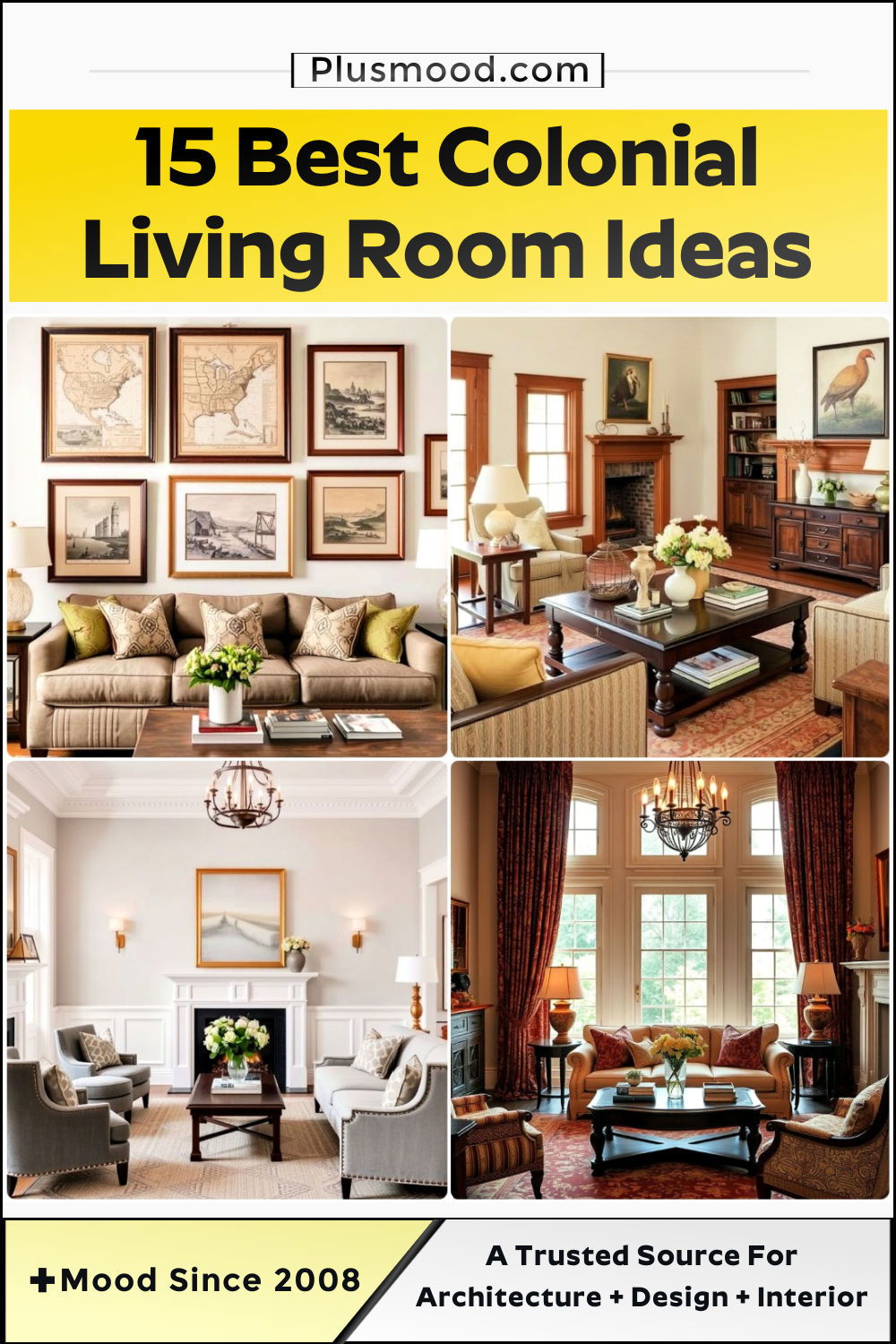
1. Embrace Natural Wood Tones
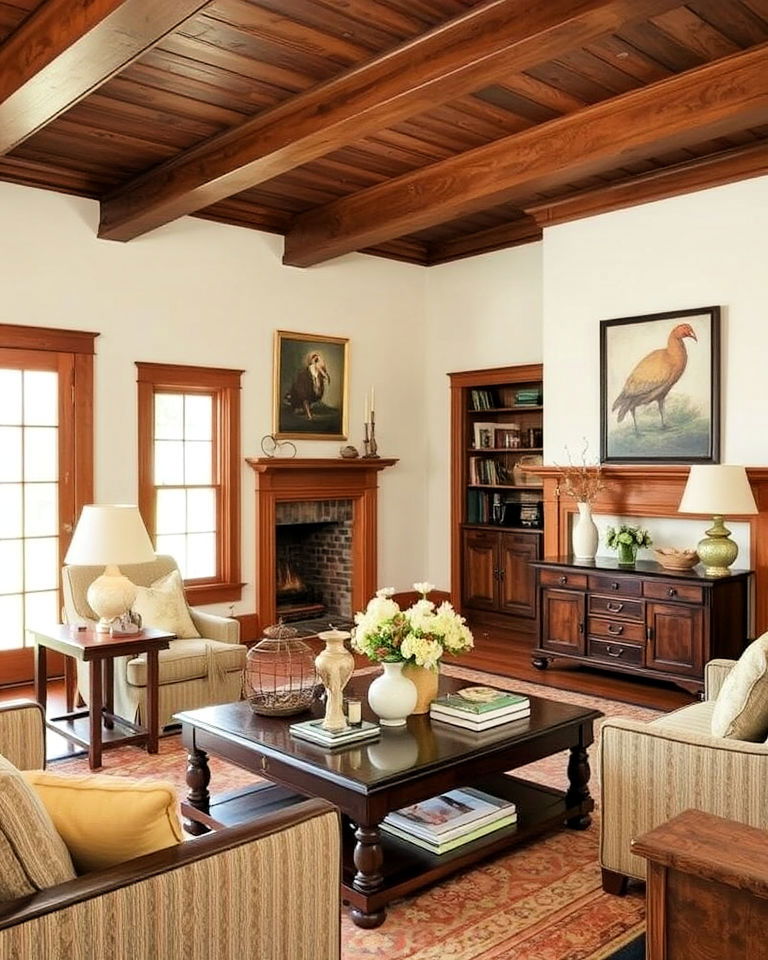
Incorporate the warmth and texture of natural wood to evoke a colonial-era aesthetic. Dark mahogany or oak furniture, including coffee tables or sideboards, instantly adds an authentic touch. The beauty of these rich wood tones lies in their durability and timeless appeal, creating a cozy, welcoming environment. Pair these with wooden beams on the ceiling or hardwood flooring to further enhance the classic, historical look. Natural wood brings a sense of groundedness that is both elegant and enduring.
2. Incorporate Antique Furniture Pieces
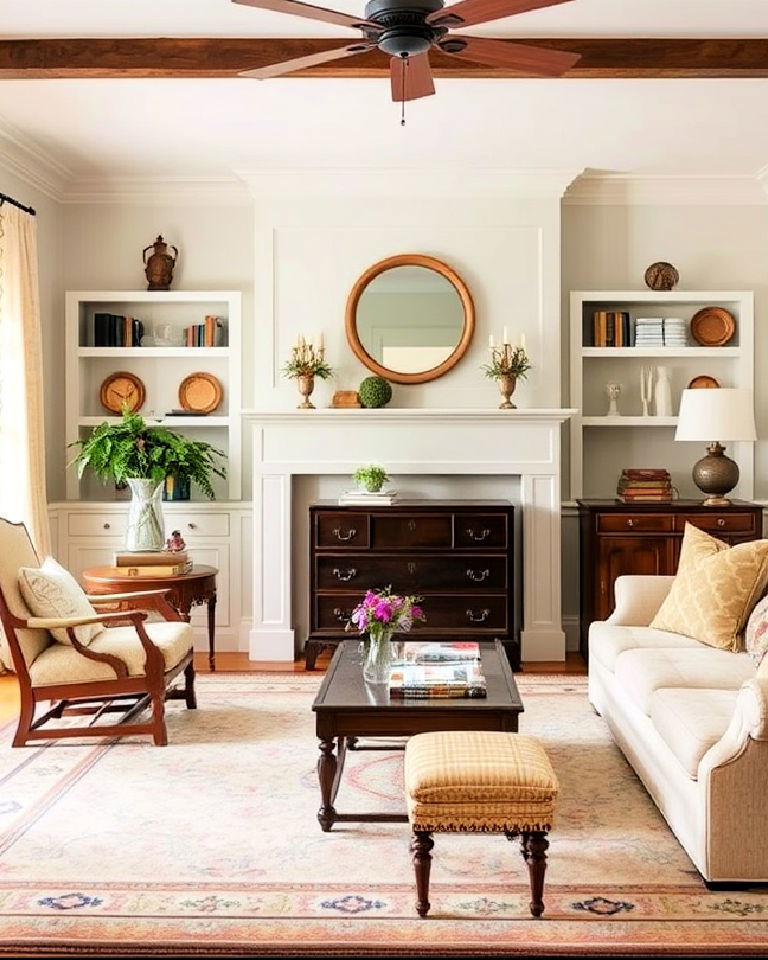
Colonial-style living rooms thrive with the inclusion of carefully selected antique furniture. Opt for pieces like a classic wooden armchair, a Chippendale sofa, or a well-worn chest of drawers. These vintage items not only add character but also serve as functional decor that tells a story. In a space where tradition meets comfort, antiques effortlessly bridge the gap between historical charm and modern livability, making your living room feel both curated and comfortable.
3. Use Neutral Color Palettes
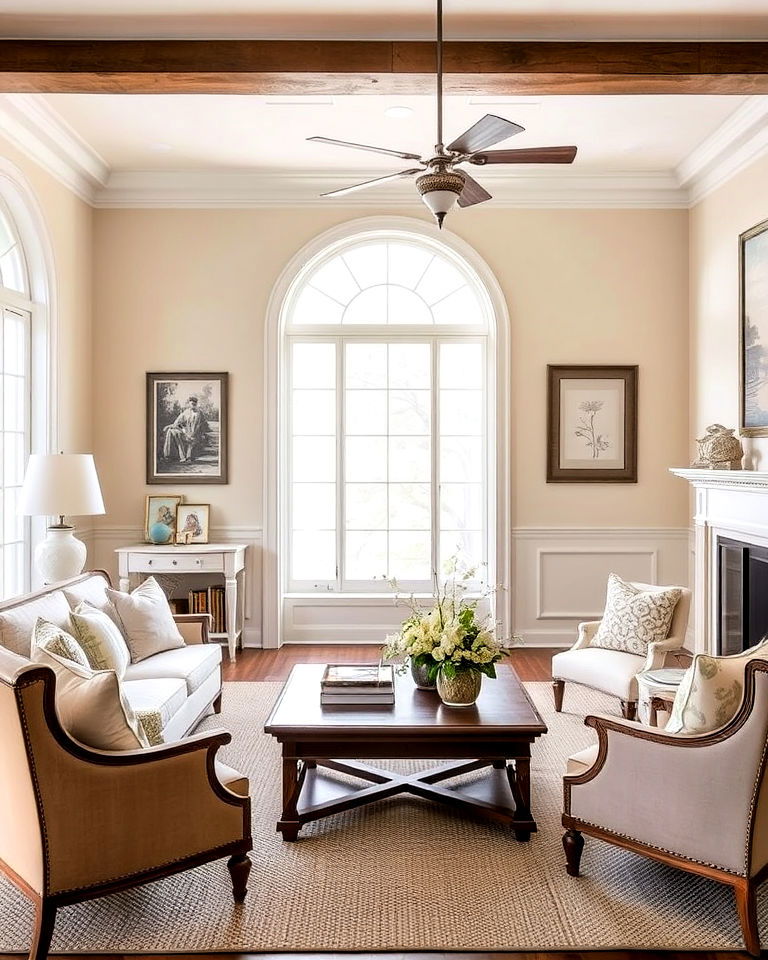
Discover timeless colonial living room ideas that bring charm and warmth to your home. Neutral shades like soft creams, warm beiges, and muted grays create a serene foundation, as highlighted in neutral living room ideas, for a colonial-inspired living room. These colors were historically used to reflect the natural surroundings and work beautifully as a backdrop for dark wood furniture or antique accents. The simplicity of the palette helps maintain the understated elegance of colonial design, allowing the room's architecture and key pieces to shine. This calming color scheme also provides flexibility when layering textiles and accessories.
4. Incorporate Wainscoting and Moldings
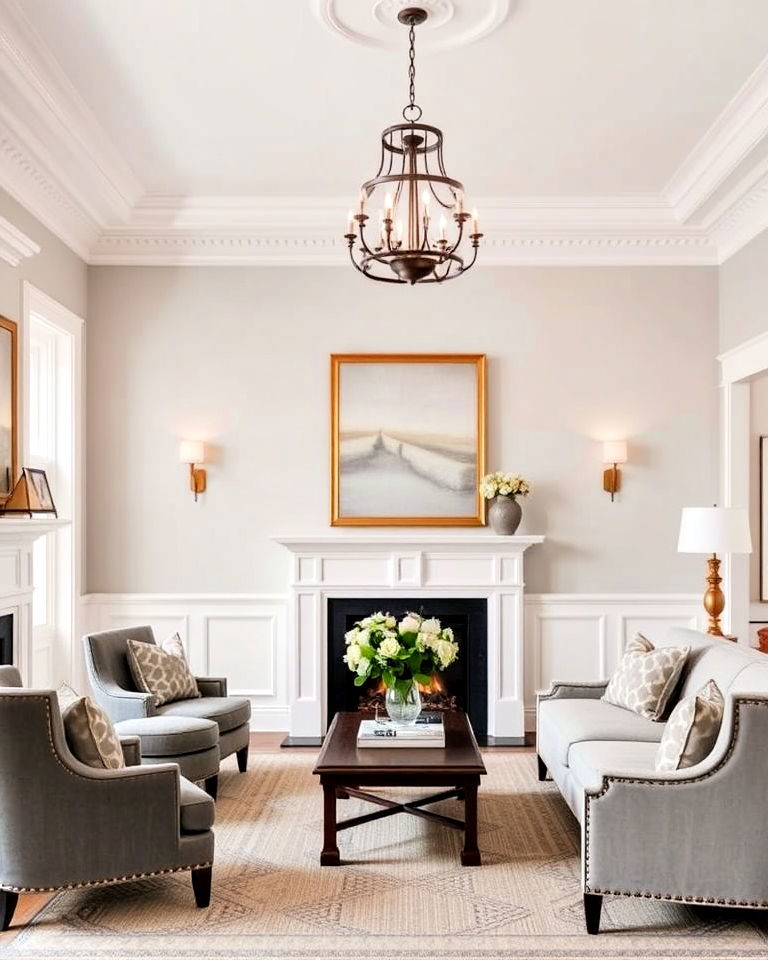
Wainscoting and detailed crown moldings bring an authentic colonial flair to your living room. These classic architectural details were common in colonial homes, offering both aesthetic appeal and a sense of structure. Wainscoting along the lower half of the walls, painted in a crisp white or soft gray, creates visual interest without overwhelming the space. The result is a polished, formal look that subtly elevates the room's overall design while preserving its historical roots.
5. Display Vintage Maps and Prints
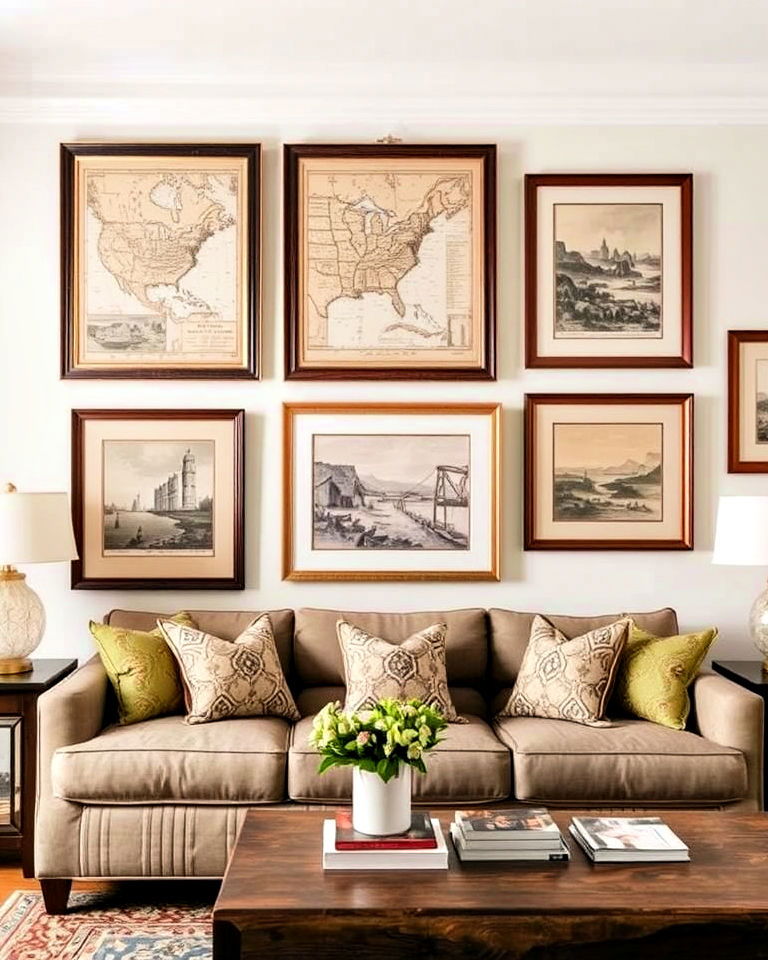
Decorate your living room walls with vintage maps or historical prints, as showcased in living room wall decor ideas, to give it a colonial-era atmosphere. Framed antique maps evoke a sense of adventure and exploration, which were key themes during the colonial period. Paired with other framed prints of classic landscapes or 18th-century drawings, these pieces serve as conversation starters while also reinforcing the historical theme. The soft, faded tones of these artworks add texture and visual depth to the walls.
6. Opt for a Traditional Fireplace
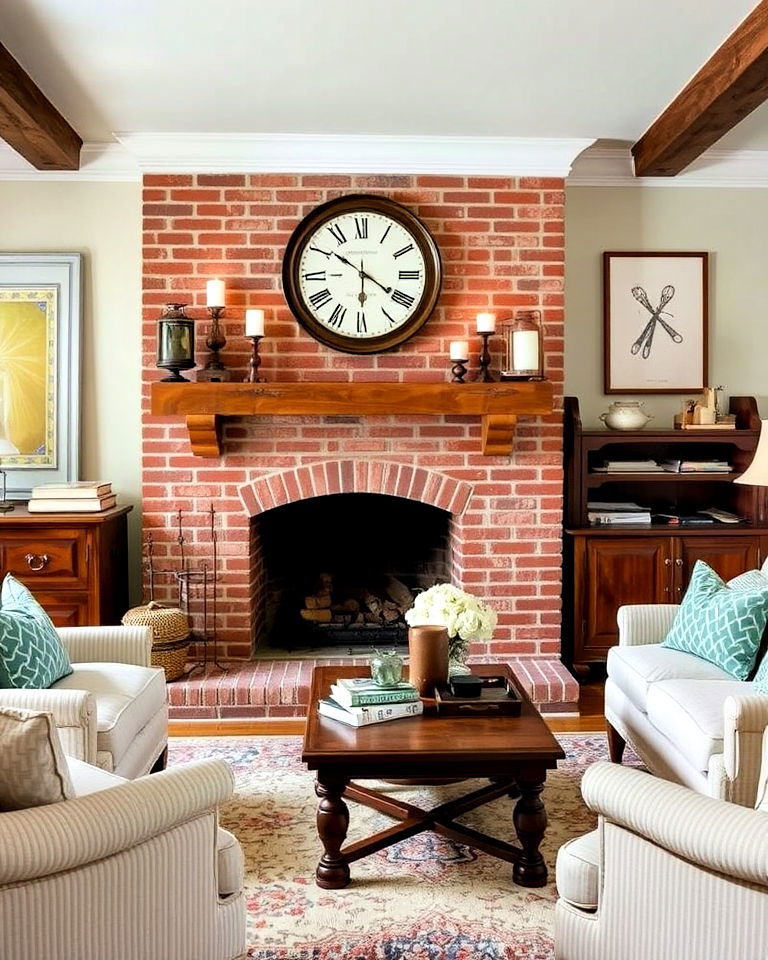
A colonial living room feels complete with the addition of a traditional fireplace as a focal point. Whether made of brick or stone, a fireplace adds warmth and authenticity to the room. In colonial times, fireplaces were essential for heat, and incorporating one in your modern living space honors that tradition. Surround it with a wooden mantel and accessorize with vintage candle holders or lanterns, as suggested in fireplace decor ideas, to complete the look. The hearth serves as a cozy gathering place for family and friends.
7. Integrate Patterned Rugs
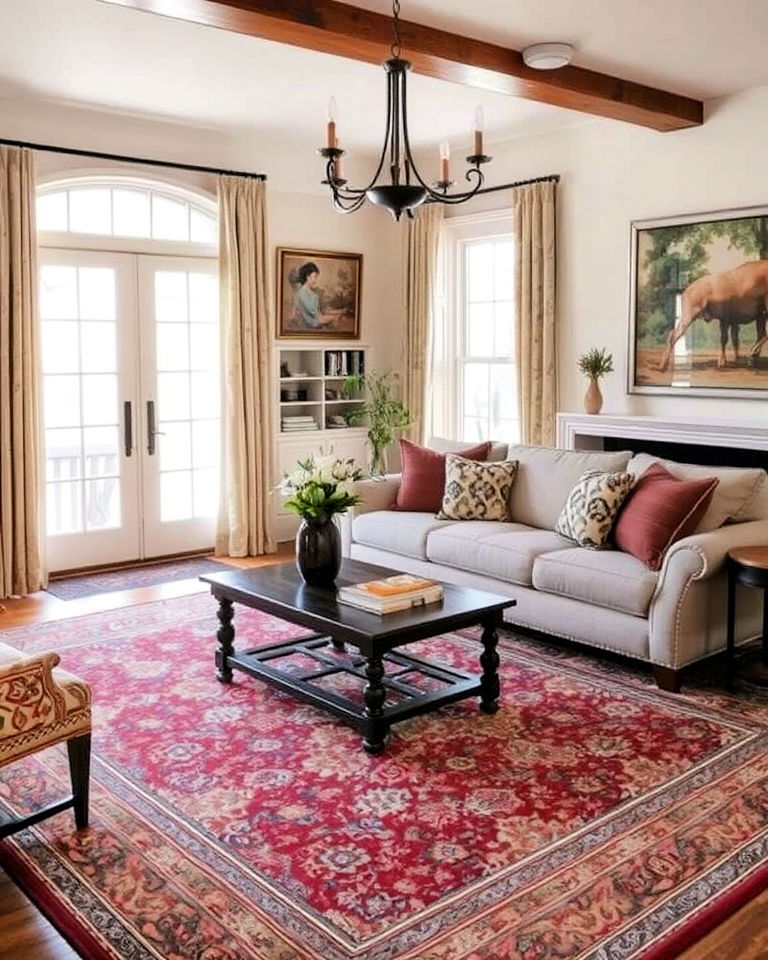
Patterned area rugs with intricate designs, such as Persian or oriental styles, complement colonial decor beautifully. These rugs bring in texture, color, and a sense of history. Placed under a coffee table or in the center of the living room, they anchor the space and provide a cozy, inviting atmosphere. Colonial homes often featured woven textiles, and adding a patterned rug is a nod to that tradition while also infusing a layer of comfort and sophistication.
8. Add Built-In Bookshelves
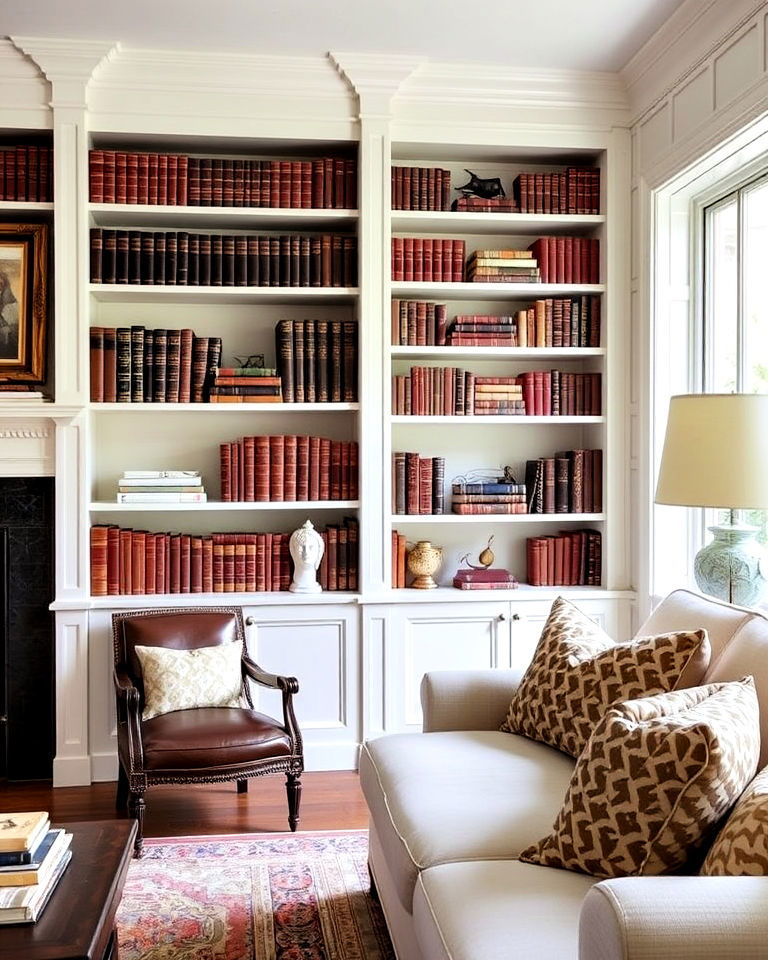
Create a classic atmosphere with a colonial-style living room featuring rich wood and elegant decor. Built-in bookshelves, as highlighted in living room bookshelf ideas, often found in colonial homes, provide both functionality and historical charm to a living room. Filling these shelves with leather-bound books, classic literature, and decorative antiques adds character and a sense of intellectual refinement. Besides being practical storage, these built-ins also create a focal point in the room. Painted in traditional white or dark wood, they integrate seamlessly into the colonial style while offering a space to showcase curated collections.
9. Hang Brass or Iron Chandeliers

Lighting plays a significant role in achieving the colonial look, and a brass or iron chandelier makes an elegant statement in a living room. These materials were commonly used in colonial times, and their sturdy, handcrafted appearance brings a touch of grandeur to the space. Suspended over the seating area or as a centerpiece above a coffee table, these fixtures add both functionality and vintage charm. The warm glow from a chandelier enhances the cozy atmosphere typical of colonial interiors.
10. Incorporate Classic Window Treatments

Dress your windows with heavy drapery or simple wooden shutters, as suggested in window treatment ideas, to align with colonial aesthetics. Classic window treatments not only add privacy but also emphasize the traditional feel of the room. Opt for rich fabrics like velvet or brocade for a luxurious look, or keep it simple with crisp white cotton for a more understated approach. The texture and weight of the fabric, paired with neutral colors, enhance the historical ambiance while providing a practical function.
11. Use Vintage Lanterns and Candle Holders
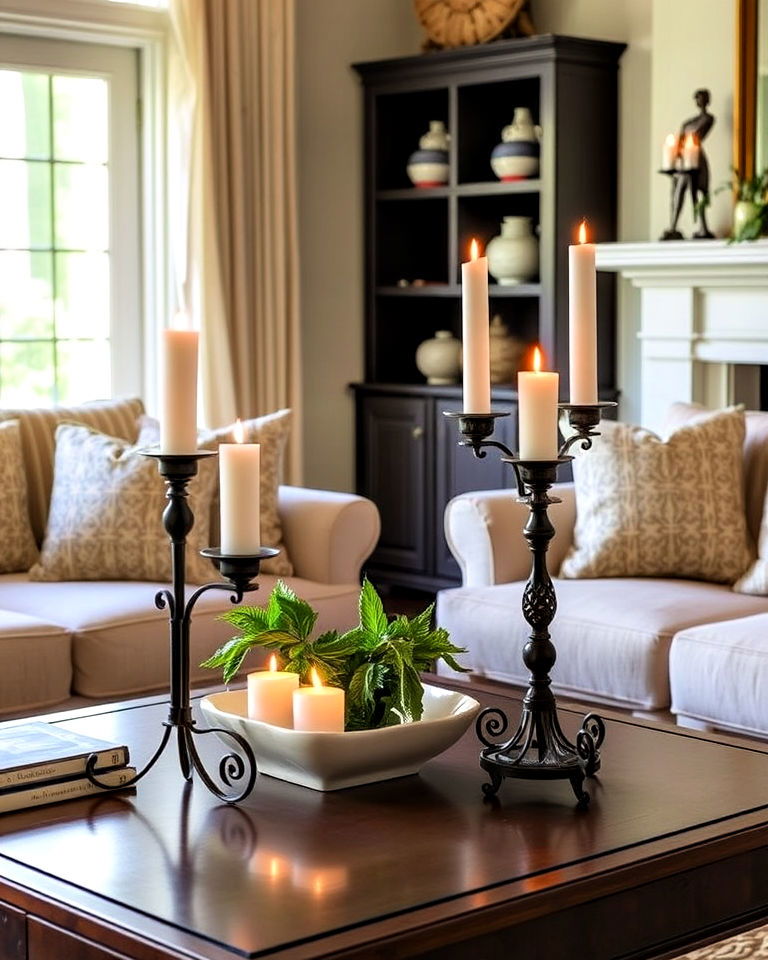
Incorporating vintage lanterns, as shown in lantern decor ideas, or wrought-iron candle holders brings colonial living room decor full circle. Historically, lighting was provided by candles and lanterns, making these items essential in evoking the era's atmosphere. Scatter these pieces throughout your living room, whether on side tables, mantels, or hanging from hooks. Their soft, ambient lighting creates a warm and inviting glow, while the antique designs add a timeless quality to your decor.
12. Introduce Windsor Chairs
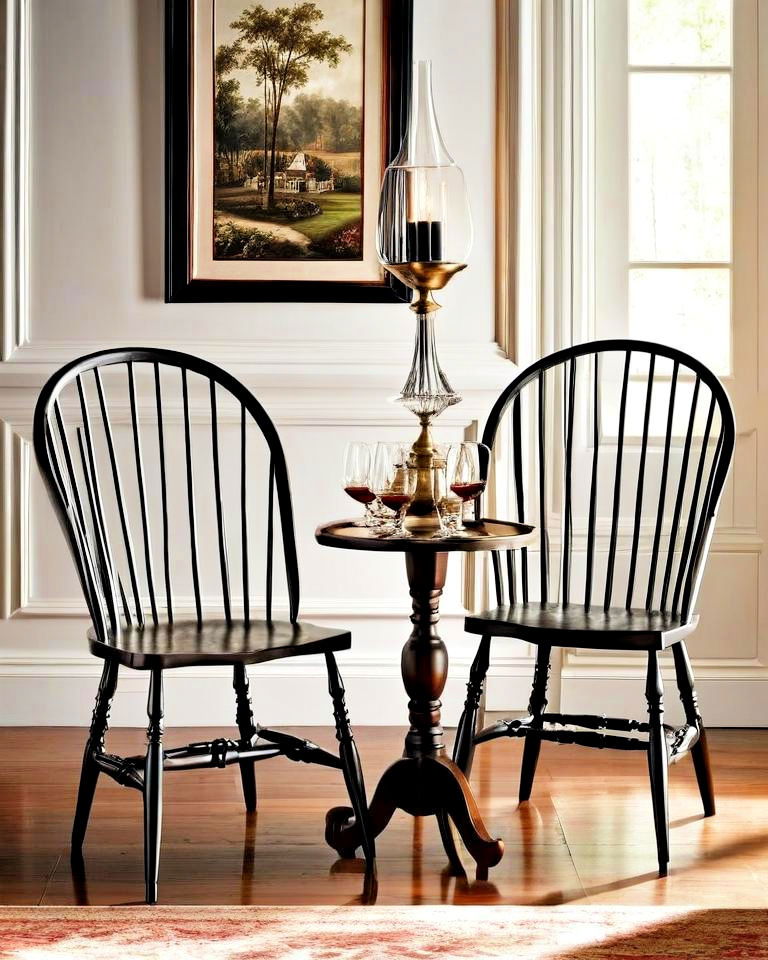
Windsor chairs, known for their simple yet elegant design, are quintessential to colonial decor. These chairs can be added as accent seating in the living room, complementing a more modern sofa or loveseat. Made from wood with a curved back and spindles, Windsor chairs bring an air of craftsmanship and tradition. Their lightweight and versatile design allows them to fit easily into any corner, offering both functionality and historical authenticity to your living space.
13. Feature Colonial-Era Artwork
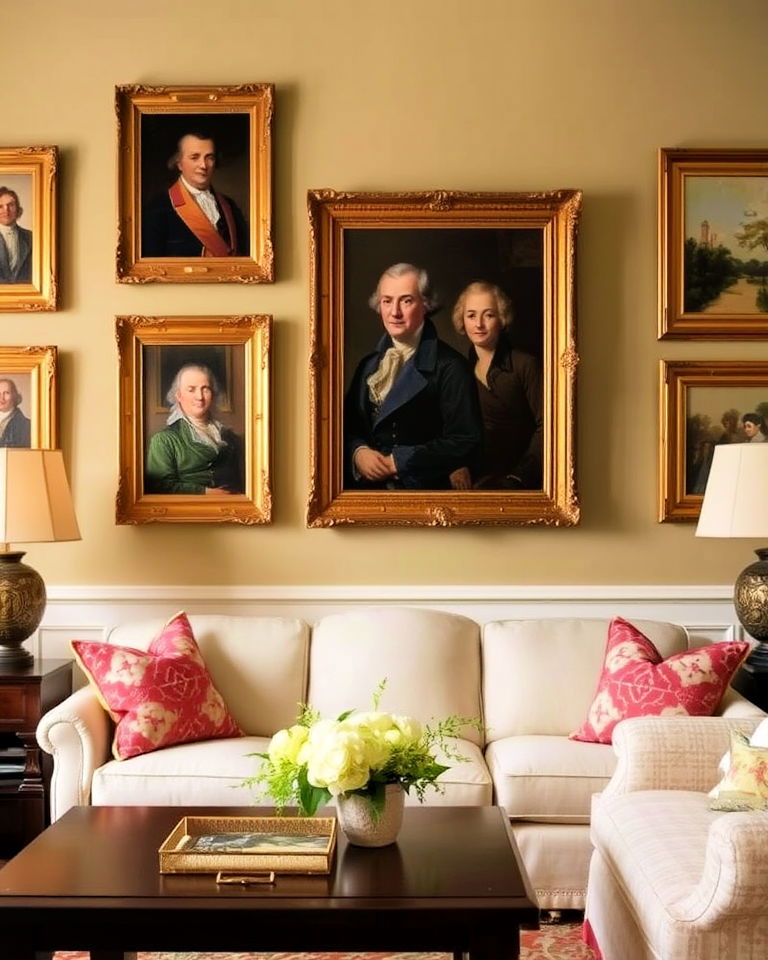
Colonial artwork, such as portraits or still lifes, gives your living room a curated, museum-like atmosphere. These pieces, often framed in ornate gold or wooden frames, add a sophisticated touch to the space. Whether you choose portraits of historical figures or nature-inspired scenes, the artwork serves as a window into the past, adding depth and character to your walls. Displaying these pieces helps tie together the overall colonial theme while making a striking visual impact.
14. Choose Upholstered Furniture with Classic Patterns
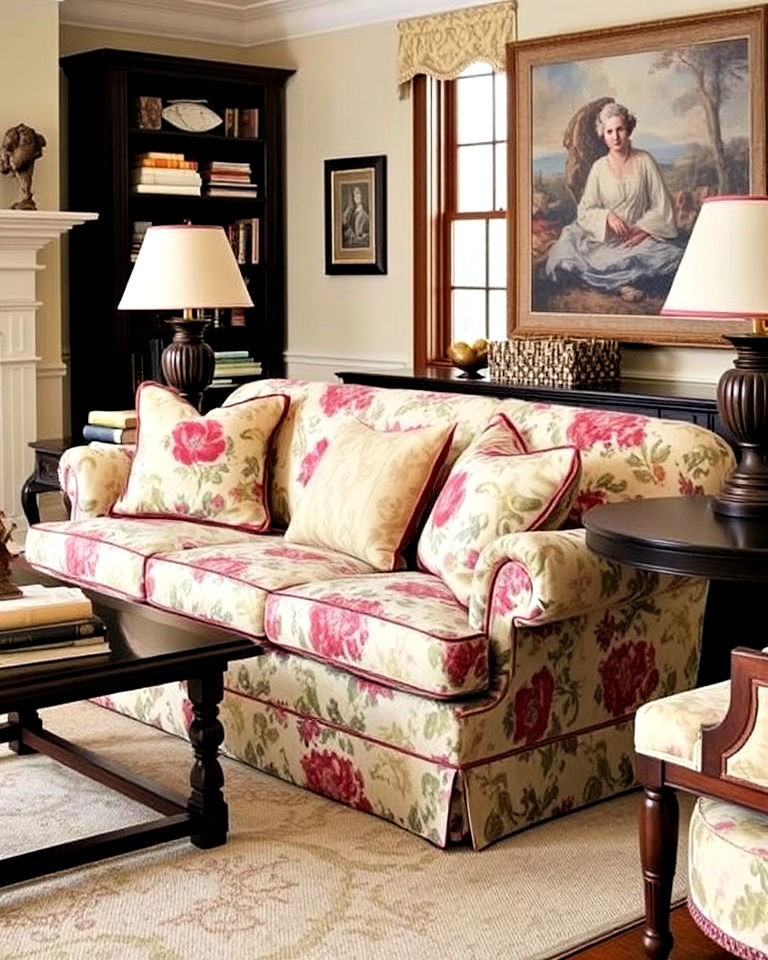
Embrace heritage with a traditional colonial living room design that combines comfort and sophistication. Upholstered furniture in classic patterns like damask, floral, or stripes can enhance the colonial aesthetic. A well-upholstered sofa or armchair in traditional fabrics offers both comfort and elegance. These textiles, popular during the colonial period, add a layer of richness to your living room decor. Paired with dark wood furniture or neutral walls, the patterns stand out beautifully, creating a sense of historical continuity while offering modern-day comfort.
15. Decorate with Pewter Accents
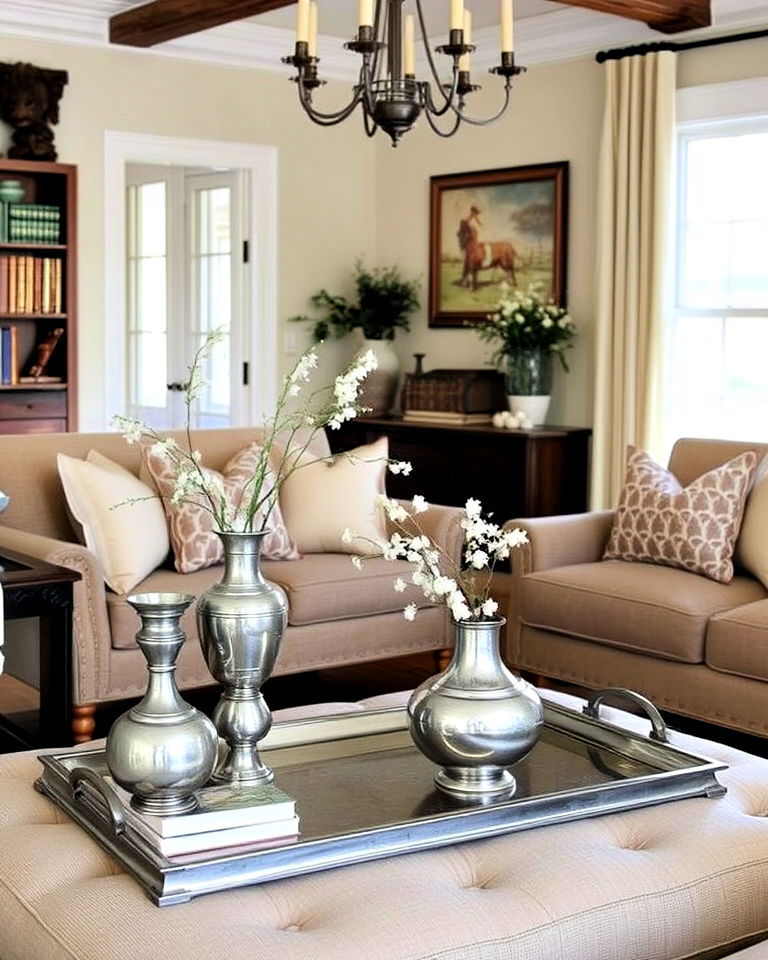
Pewter, a popular material in colonial times, can be used in small decorative accents throughout the living room. Pewter vases, trays, or candle holders add a subtle shine and vintage charm to the space. These items are ideal for decorating coffee tables, mantels, or bookshelves. The cool tones of pewter contrast nicely with the warm woods and neutral fabrics commonly used in colonial-style rooms, creating a balanced, sophisticated look.
Conclusion:
From incorporating antique furniture to featuring colonial-era artwork, there are endless ways to bring a historical yet inviting atmosphere into your home. Combining neutral color palettes with rich textures and classic patterns creates a balanced, cozy environment. The use of pewter accents and traditional window treatments adds subtle luxury, while chandeliers and built-in bookshelves provide practical, yet beautiful, focal points. By blending these elements, you'll achieve a space that honors colonial design, while staying relevant to today's aesthetic demands.
Key Points:
- Natural Wood Tones: Incorporating dark woods like mahogany or oak adds warmth and historical authenticity.
- Antique Furniture: Carefully selected antique pieces bring character and tell a story within the living room.
- Neutral Color Palettes: Soft creams and muted grays create a serene, timeless foundation that complements colonial design.
- Wainscoting & Moldings: Classic architectural details add structure and elevate the room's historical charm.
- Vintage Accents: Decorate with elements like maps, lanterns, and pewter to evoke colonial aesthetics.
- Fireplace as Focal Point: A traditional brick or stone fireplace brings warmth and ties together the colonial theme.
- Patterned Rugs & Upholstery: Textiles with intricate patterns and rich fabrics enhance comfort and historical style.
- Classic Lighting: Brass or iron chandeliers create an elegant atmosphere, reflecting colonial-era craftsmanship.
What to Do Next:
- Start by selecting a neutral color palette to lay the foundation of your colonial living room.
- Incorporate key architectural details like wainscoting and moldings to establish the theme.
- Focus on adding antique furniture and vintage accents to bring authenticity and character into the space.
- Choose lighting fixtures and textiles that complement the traditional elements for a cohesive design.

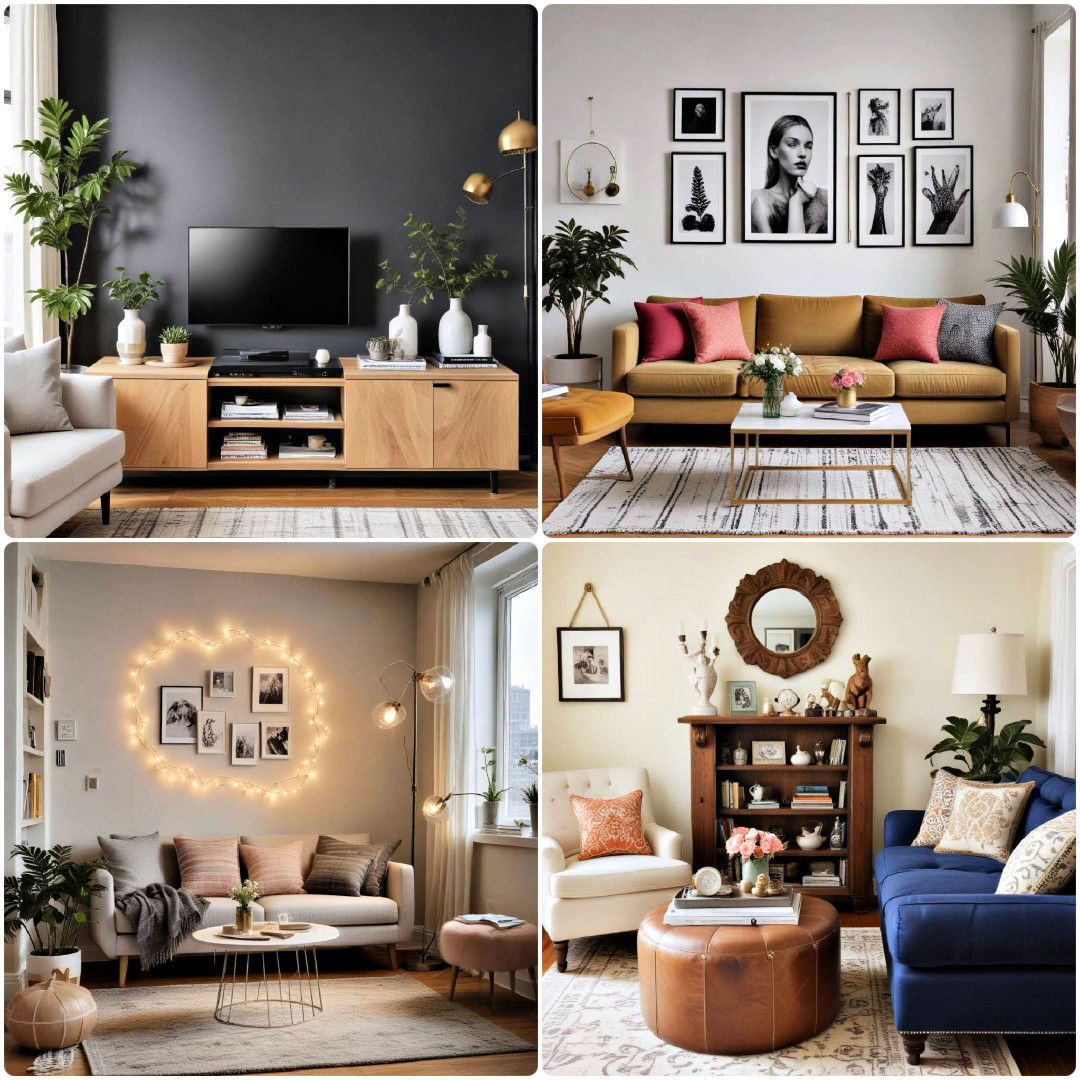
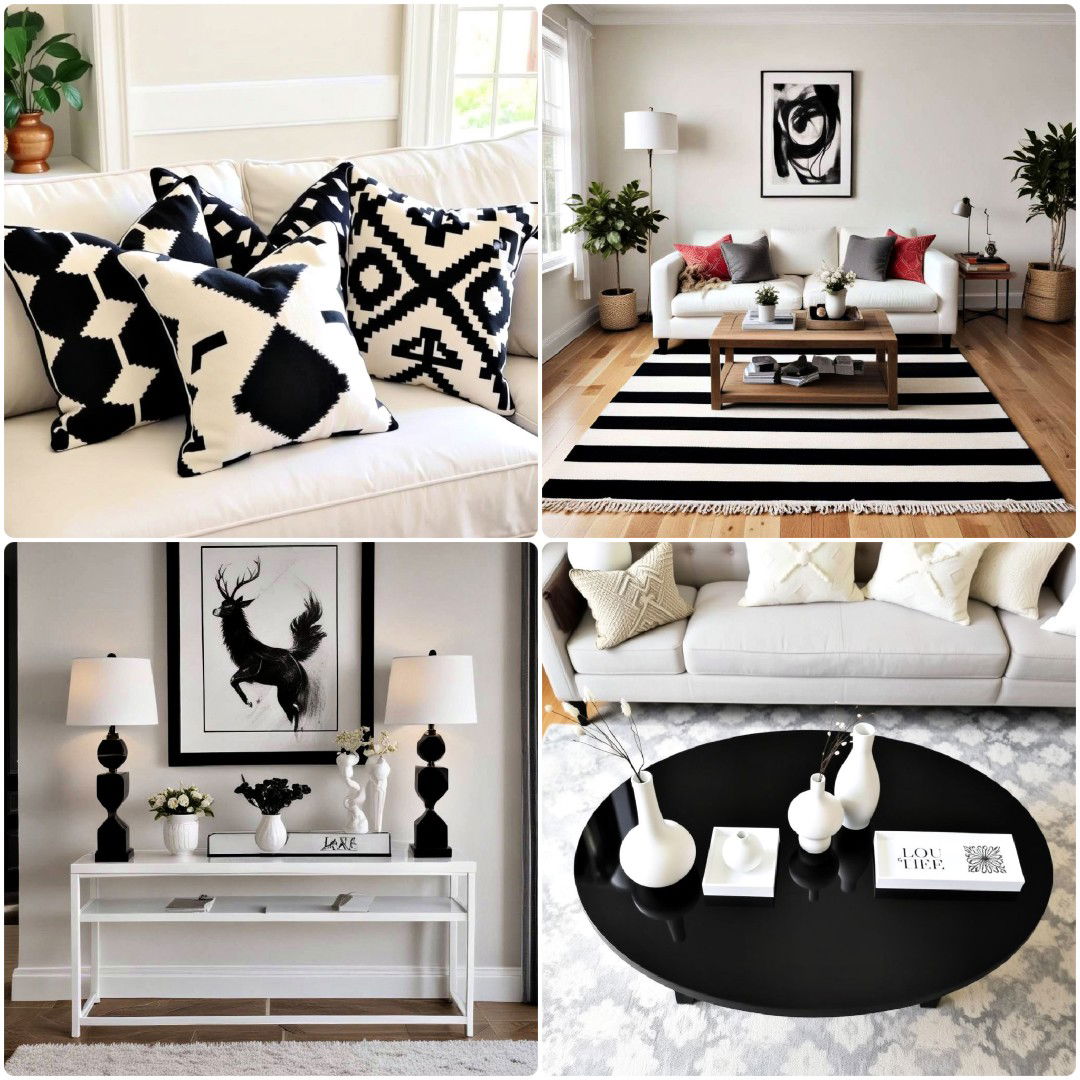
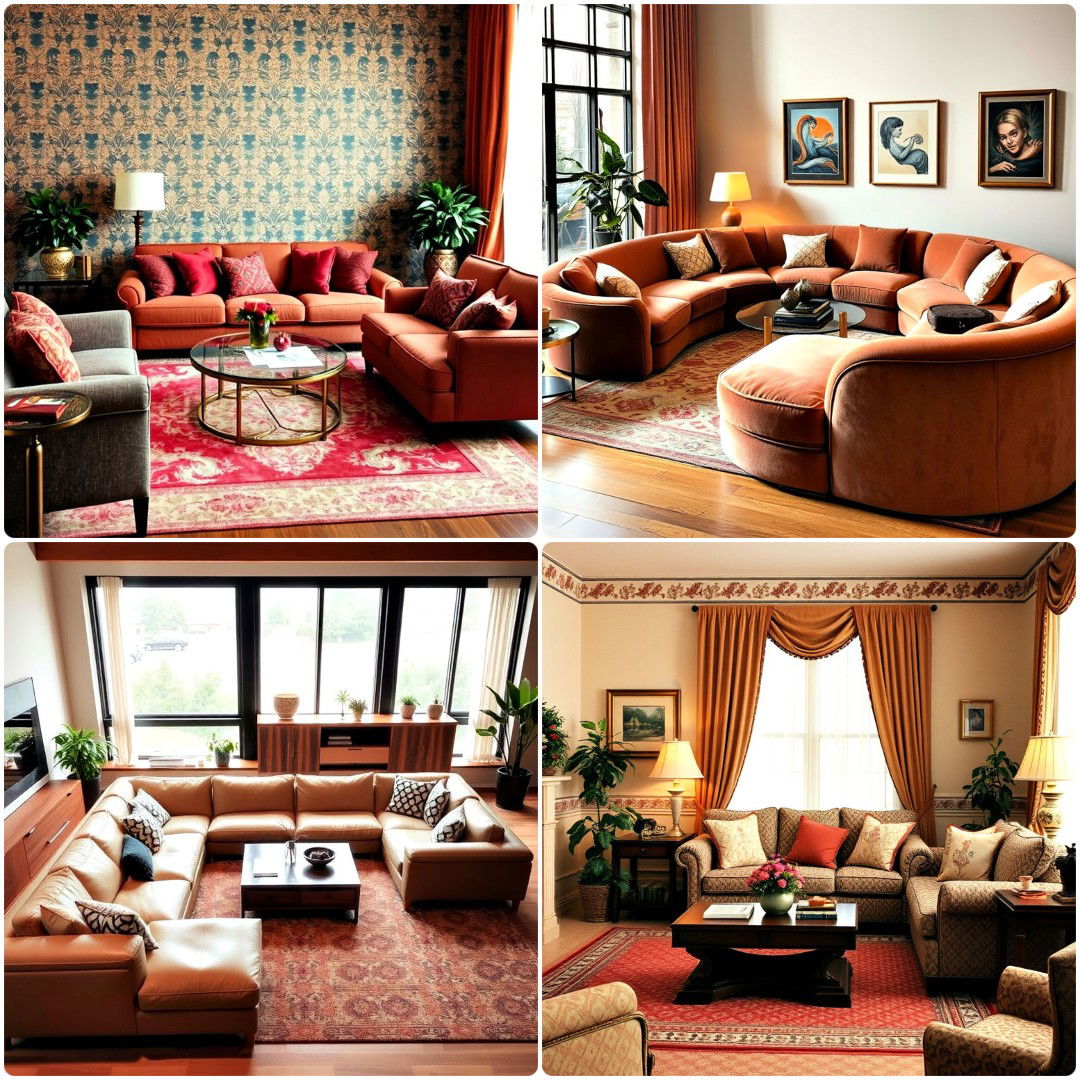
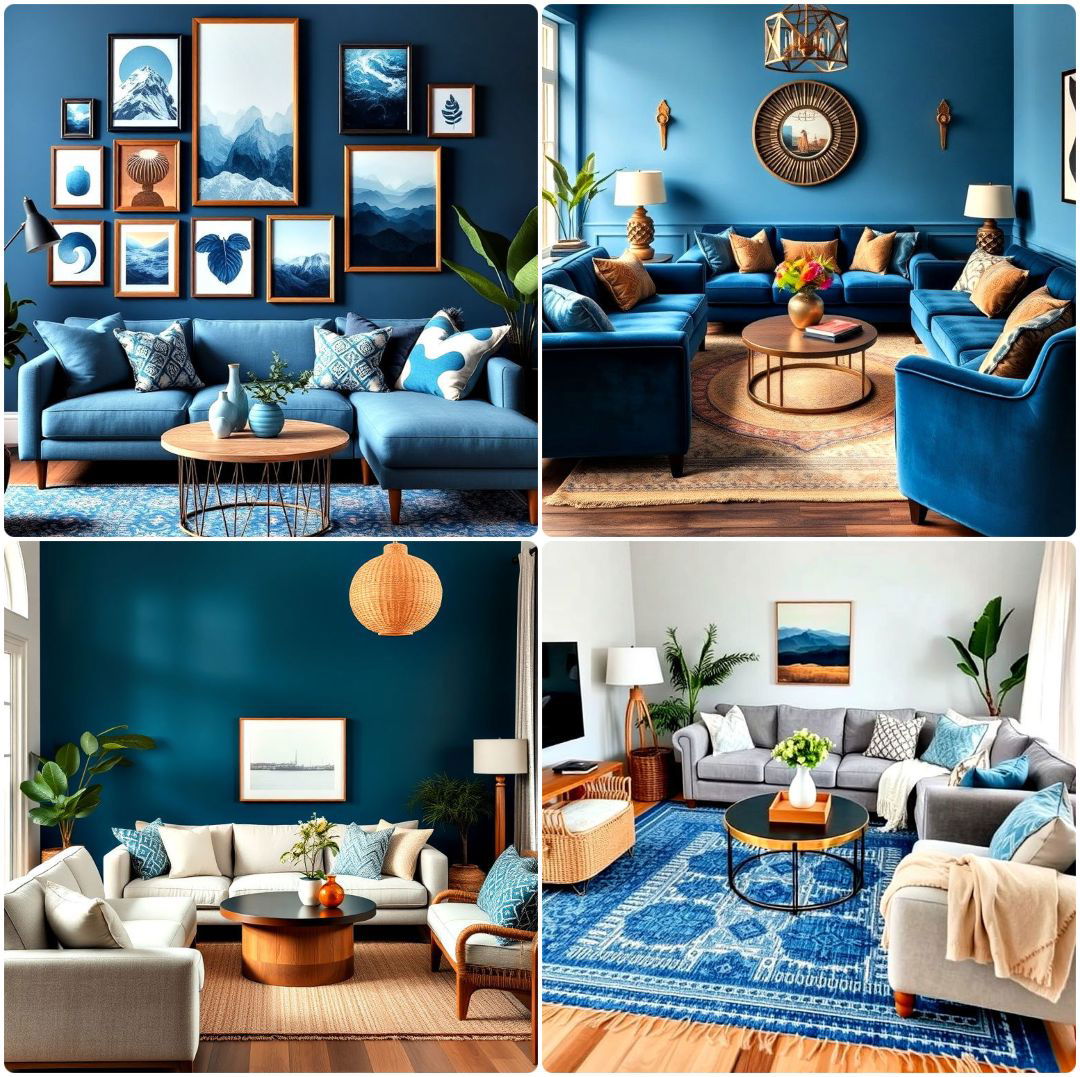
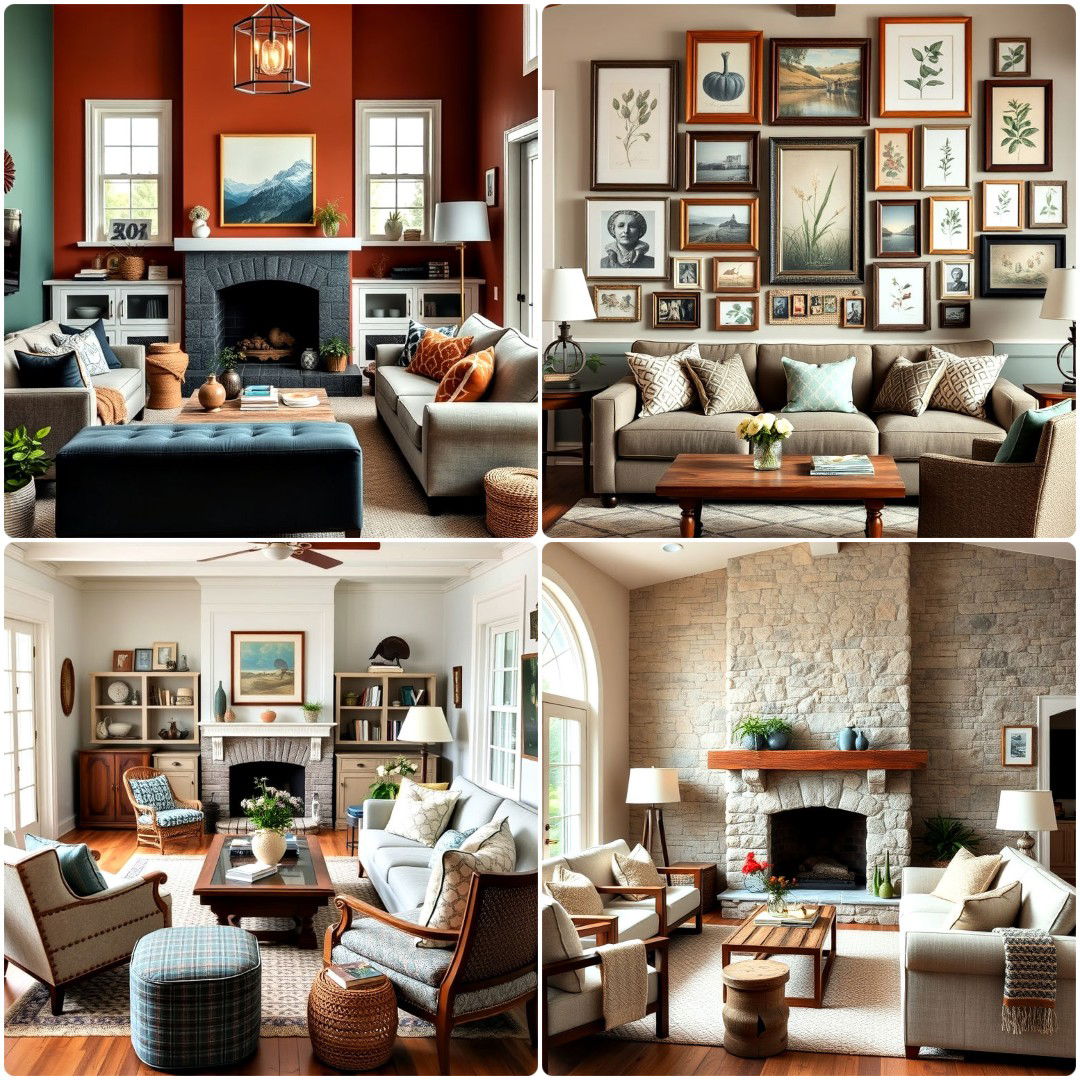
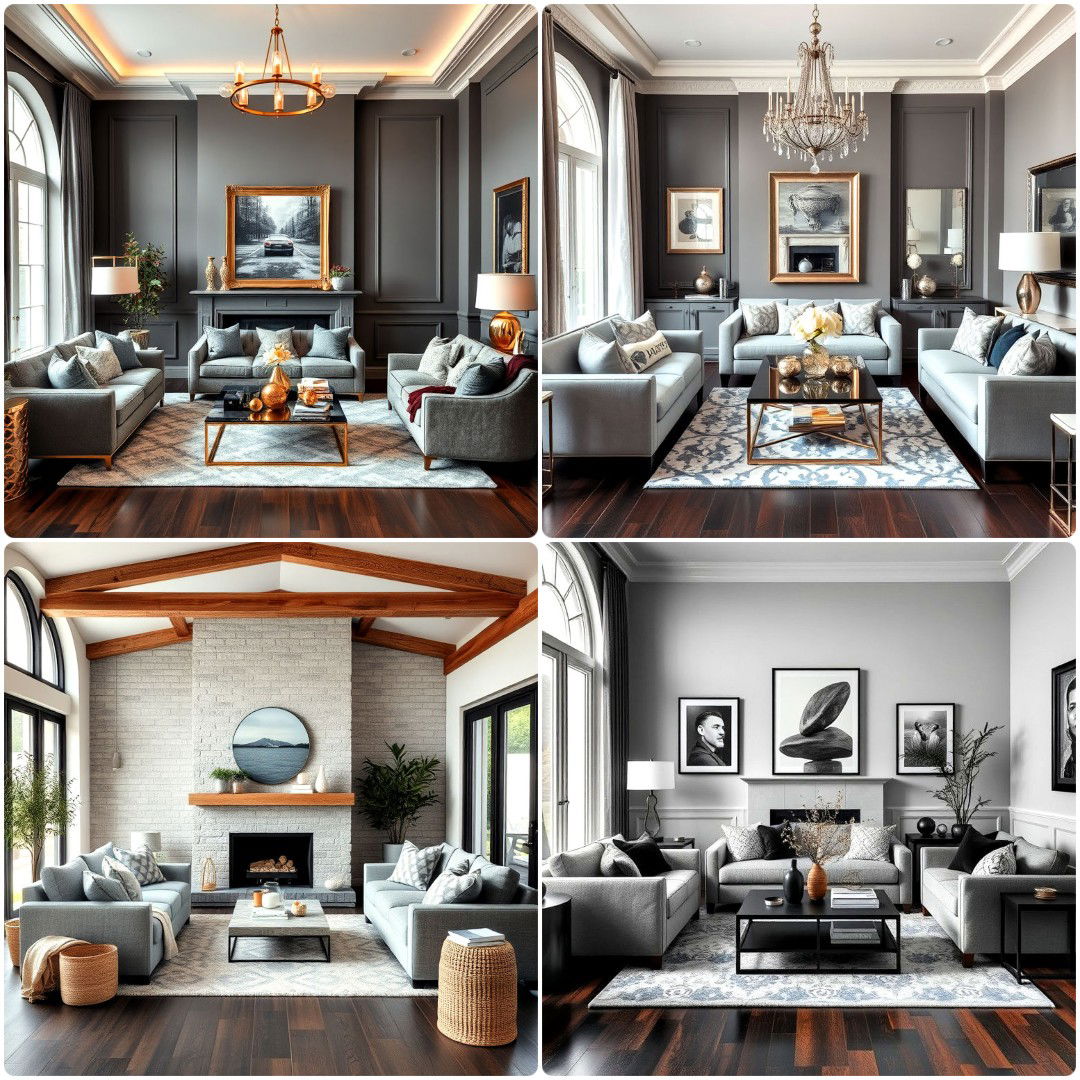
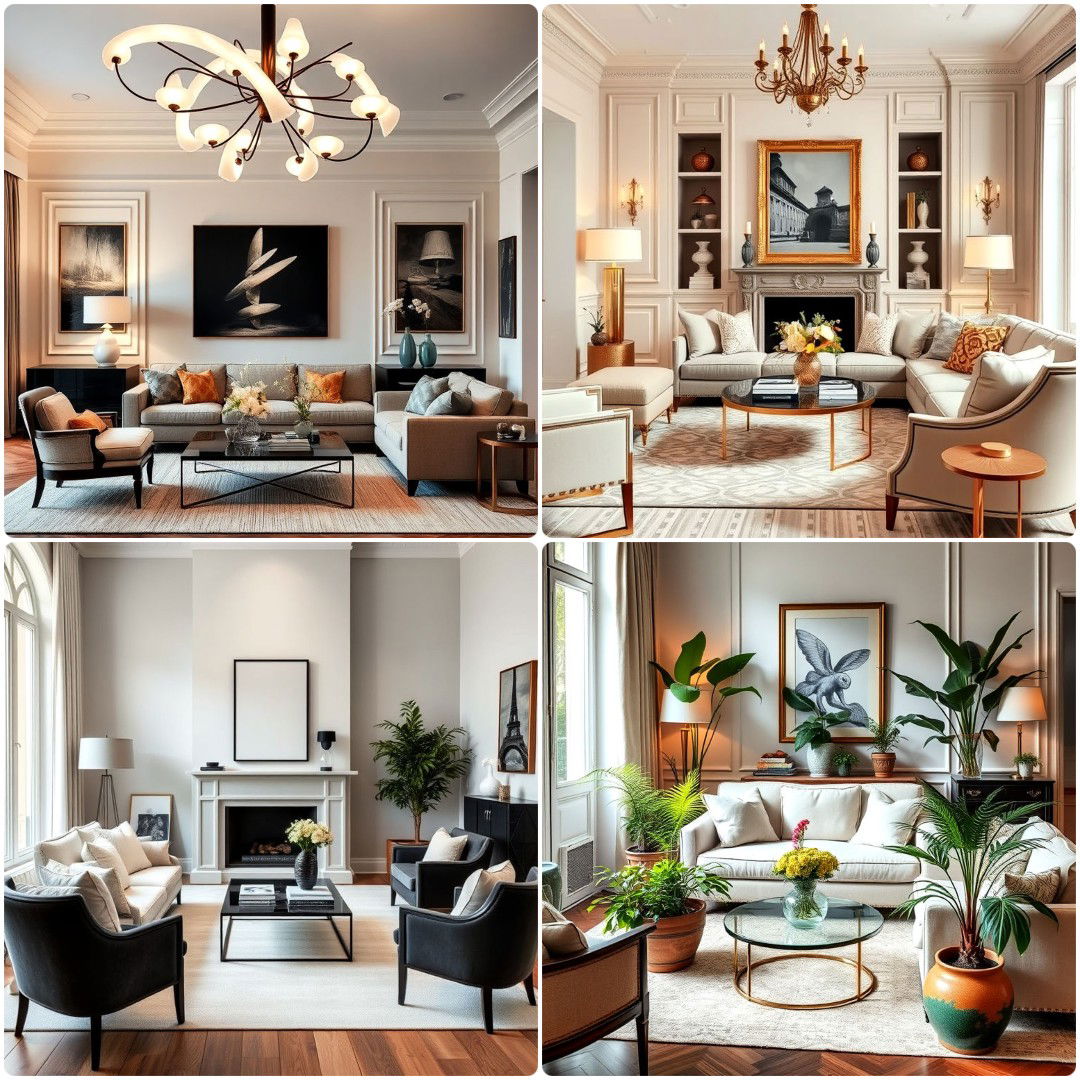
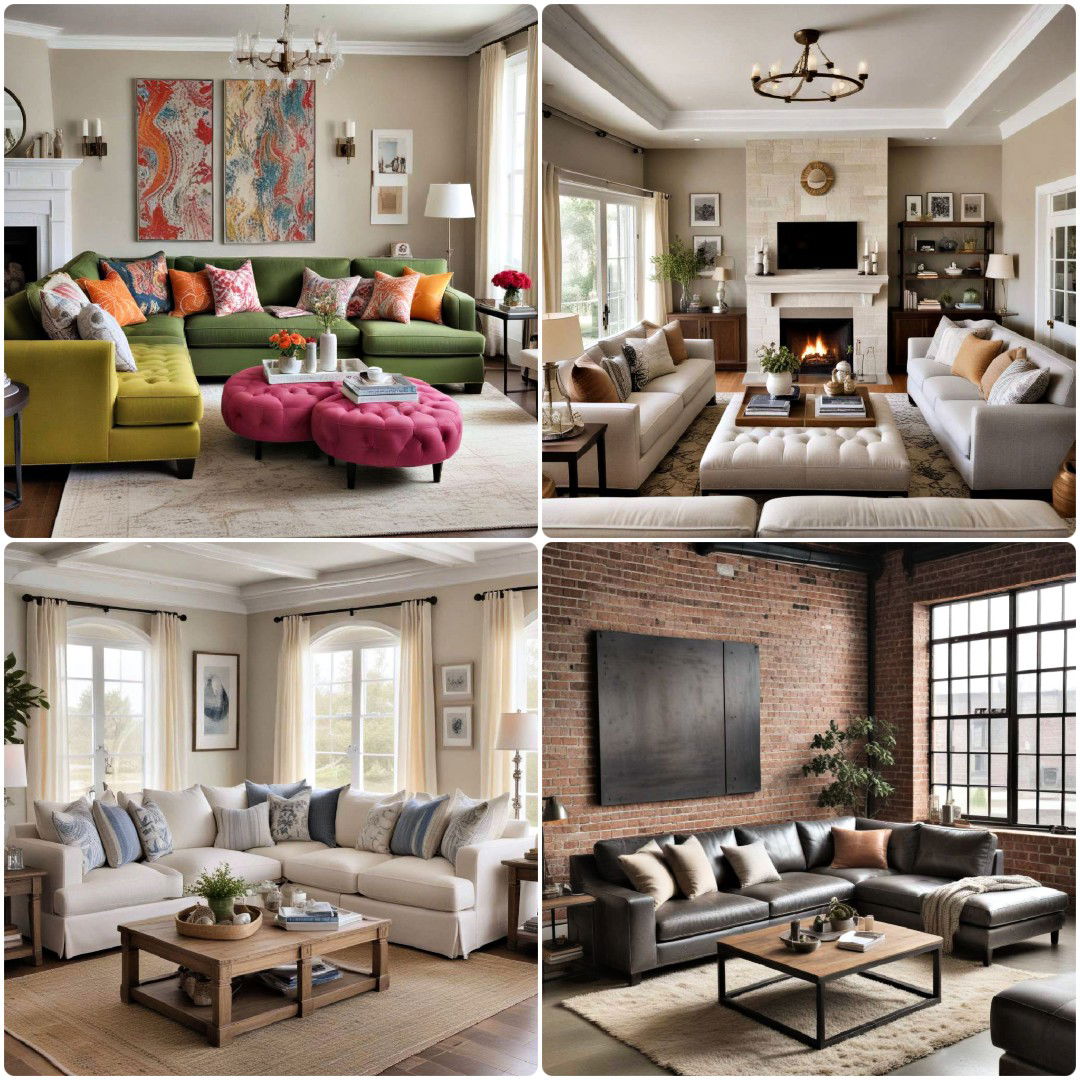
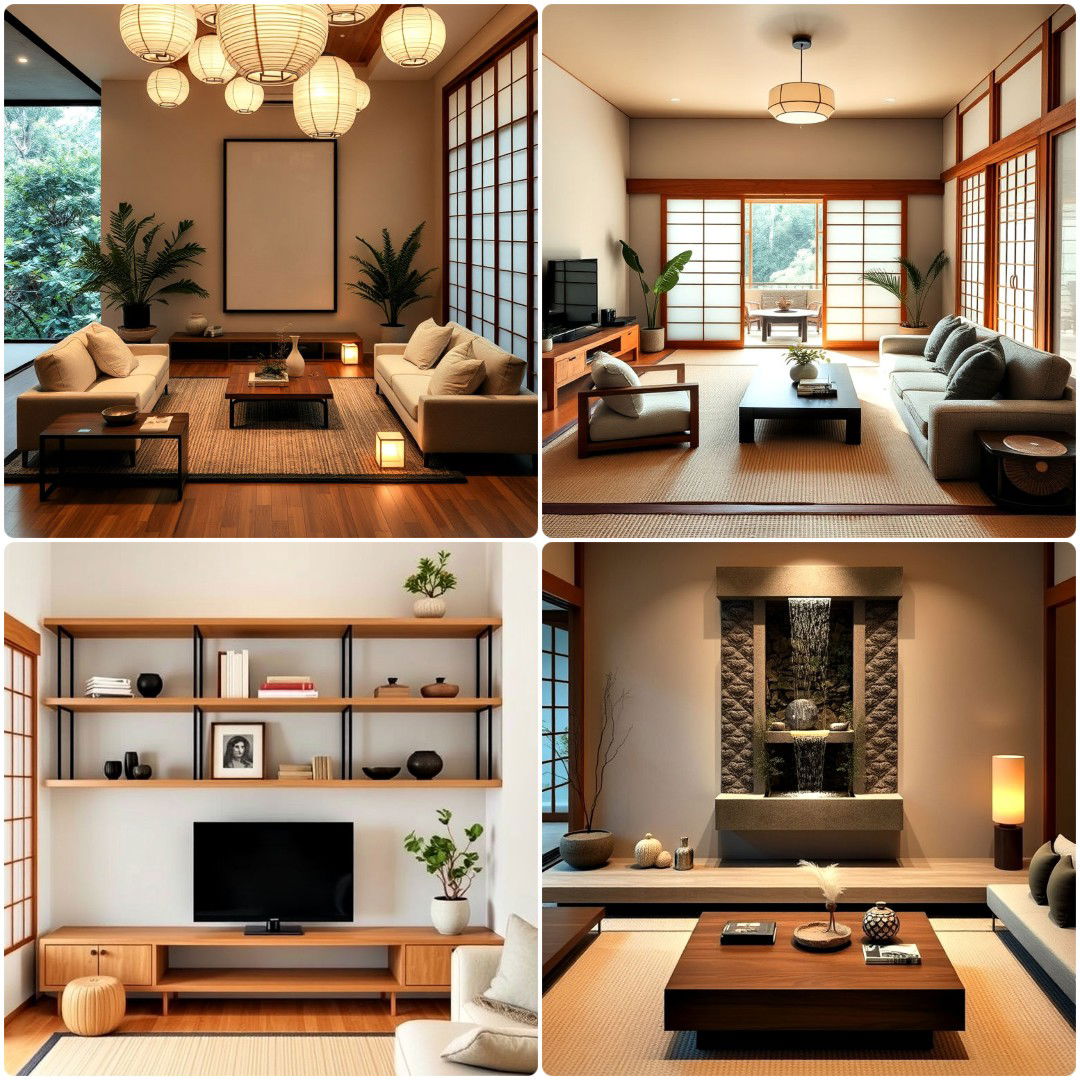
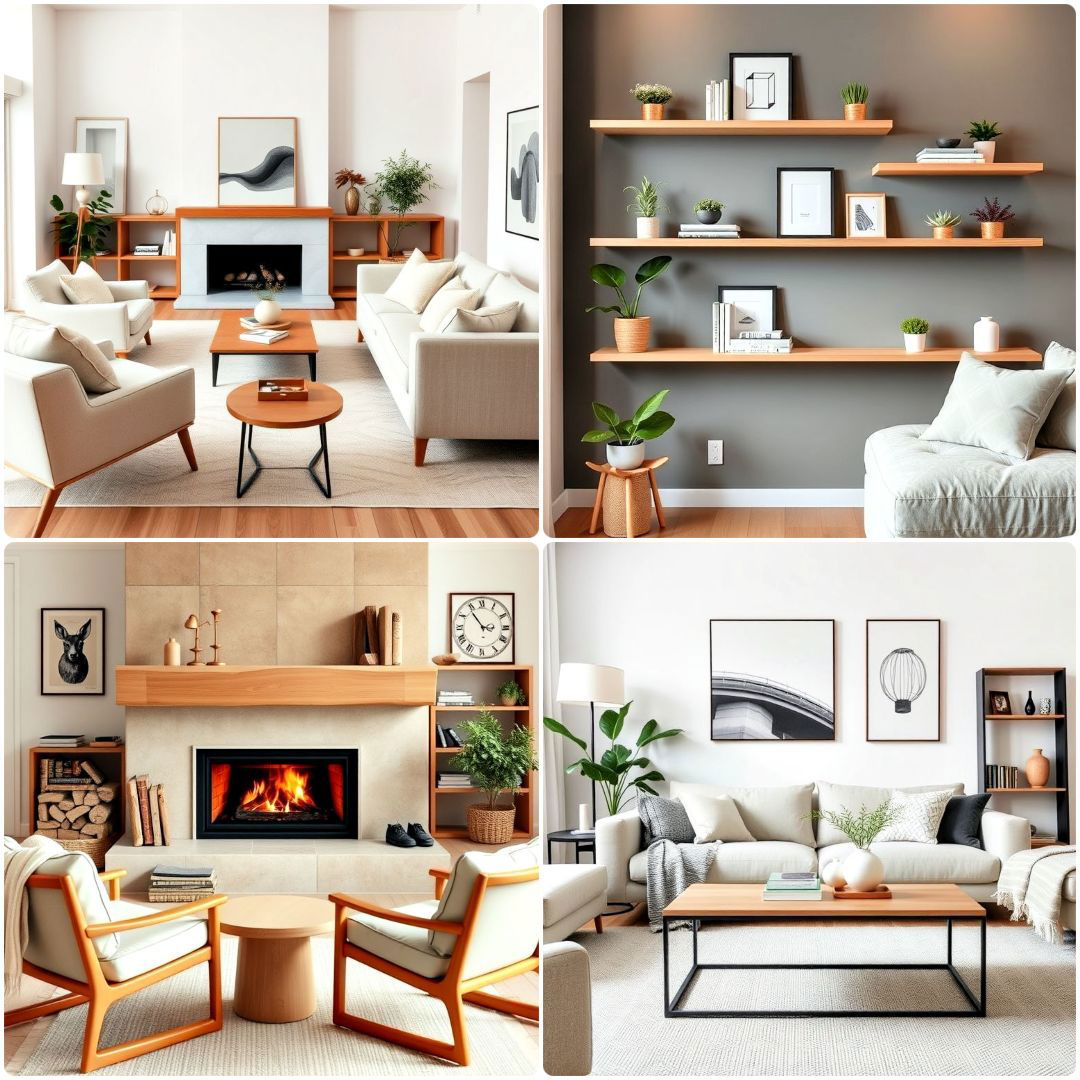
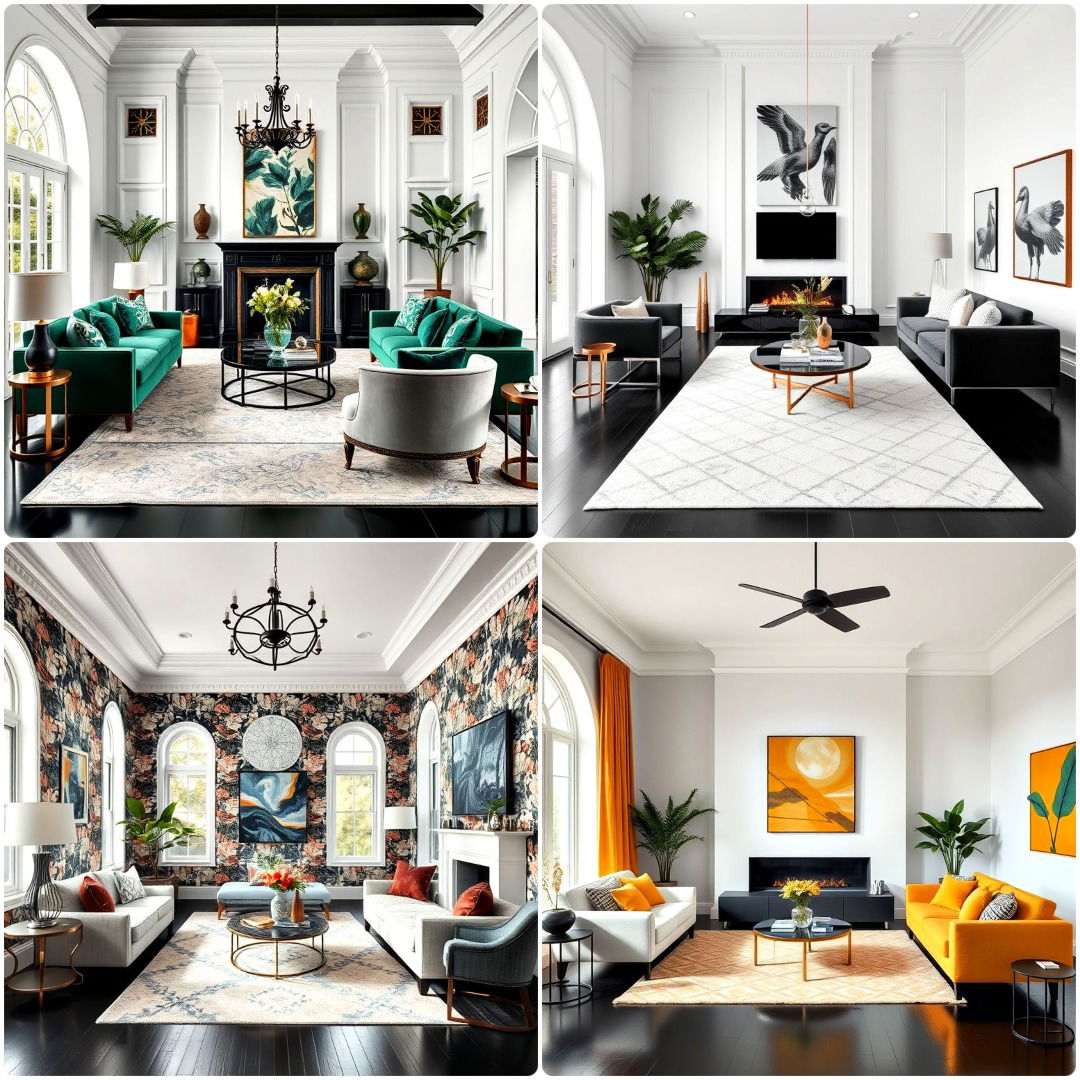
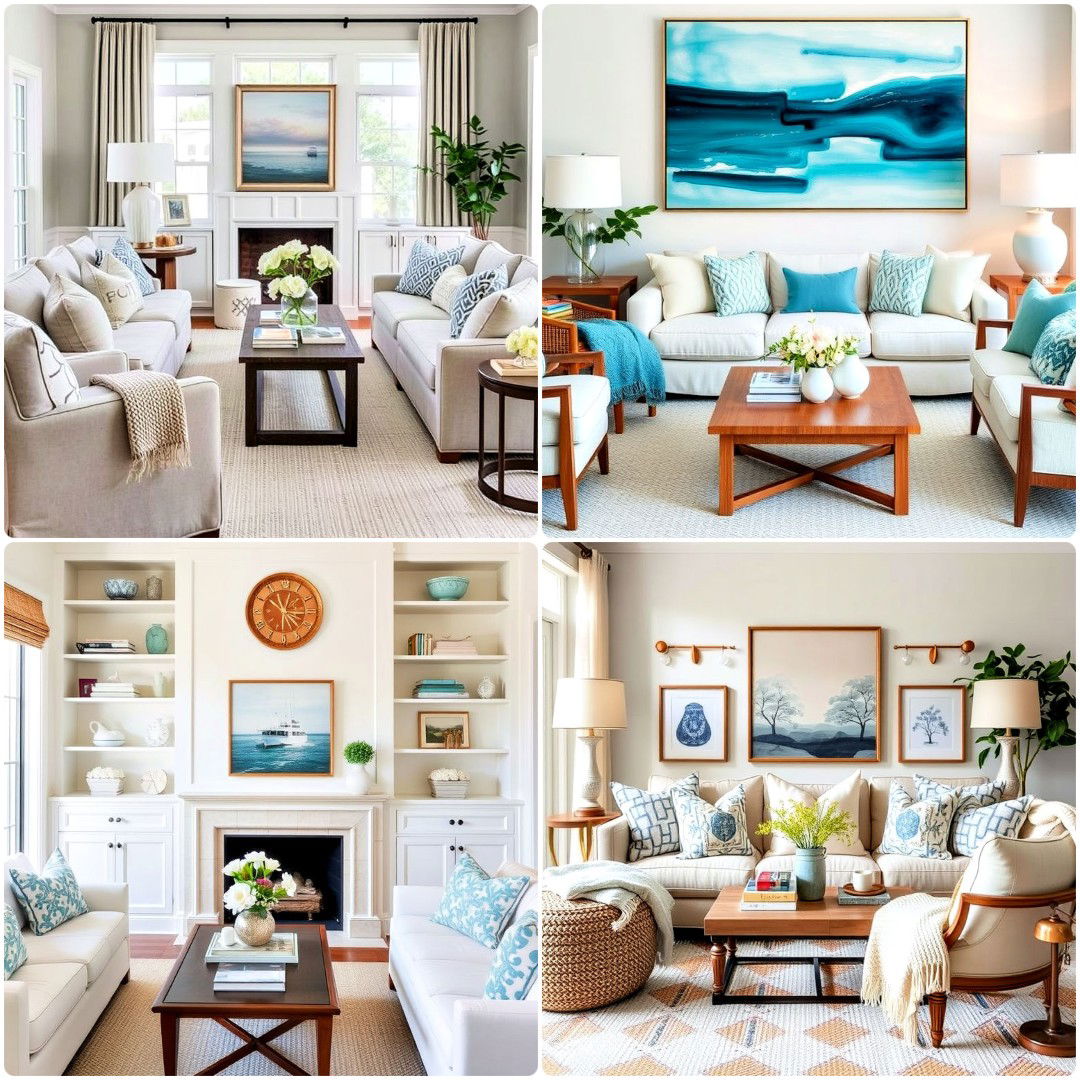
Leave a Reply